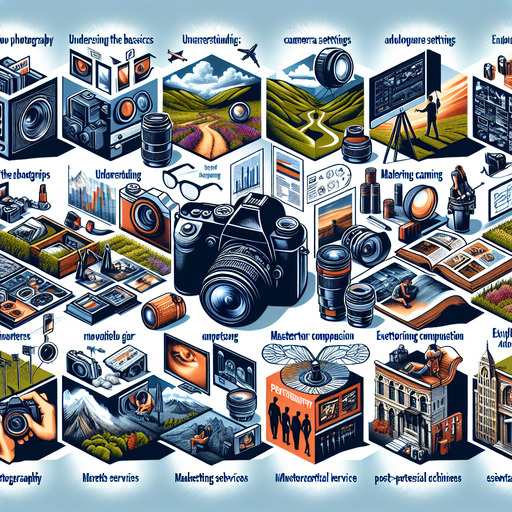
-
Table of Contents
- Mastering Photography: Tips and Techniques for Stunning Shots
- Understanding the Basics of Photography
- Mastering Camera Settings
- Composition Techniques
- Advanced Photography Techniques
- Portrait Photography Tips
- Landscape Photography Techniques
- Editing and Post-Processing
- Basic Editing Techniques
- Advanced Editing Tools
- Choosing the Right Photography Gear
- Cameras and Lenses
- Essential Accessories
- Building a Photography Business
- Marketing Your Photography Services
- Setting Up Your Photography Business
Mastering Photography: Tips and Techniques for Stunning Shots
Photography is more than just capturing moments; it’s about telling stories, evoking emotions, and creating art. Whether you’re a budding photographer or a seasoned professional, understanding the nuances of photography can elevate your work to new heights. In this guide, we’ll explore essential photography tips, techniques, and insights to help you capture breathtaking images.
Understanding the Basics of Photography
Before diving into advanced techniques, it’s crucial to grasp the fundamentals of photography. These basics form the foundation upon which all great photographs are built.
Mastering Camera Settings
Understanding your camera’s settings is the first step toward professional photography. Key settings include:
- Aperture: Controls the depth of field. A lower f-stop (e.g., f/2.8) creates a blurred background, ideal for portrait photography.
- Shutter Speed: Determines how long the camera’s shutter remains open. Faster speeds (e.g., 1/1000) freeze motion, while slower speeds (e.g., 1/30) capture motion blur.
- ISO: Adjusts the camera’s sensitivity to light. Higher ISO settings (e.g., 1600) are useful in low-light conditions but can introduce noise.
Composition Techniques
Composition is the art of arranging elements within a frame. Effective composition can transform an ordinary scene into a captivating image.
- Rule of Thirds: Divide your frame into a 3×3 grid and position key elements along the lines or intersections.
- Leading Lines: Use natural lines to guide the viewer’s eye through the photograph.
- Framing: Use elements within the scene to create a natural frame around your subject.
Advanced Photography Techniques
Once you’ve mastered the basics, it’s time to explore advanced techniques that can add depth and creativity to your work.
Portrait Photography Tips
Portrait photography is about capturing the essence of a person. Here are some tips to enhance your portrait shots:
- Lighting: Use soft, diffused lighting to flatter your subject. Natural light during the golden hour (just after sunrise or before sunset) is ideal.
- Posing: Guide your subject into natural, relaxed poses. Encourage them to interact with their environment for candid shots.
- Focus on the Eyes: Ensure the eyes are sharp and in focus, as they are the focal point of most portraits.
Landscape Photography Techniques
Capturing the beauty of nature requires patience and an eye for detail. Consider these techniques for stunning landscape photos:
- Use a Tripod: A tripod ensures stability, especially in low-light conditions or when using slow shutter speeds.
- Incorporate Foreground Elements: Adding elements in the foreground can create depth and interest.
- Experiment with Filters: Use polarizing filters to reduce glare and enhance colors, or neutral density filters for long exposure shots.
Editing and Post-Processing
Editing is an integral part of the photography process, allowing you to enhance and refine your images.
Basic Editing Techniques
Even simple edits can significantly improve your photos. Focus on:
- Adjusting Exposure: Correct underexposed or overexposed areas to achieve balanced lighting.
- Enhancing Colors: Use saturation and vibrance adjustments to make colors pop without looking unnatural.
- Cropping and Straightening: Crop to improve composition and straighten horizons for a professional look.
Advanced Editing Tools
For more complex edits, consider using advanced tools and techniques:
- Layer Masks: Apply adjustments selectively to specific areas of your image.
- Frequency Separation: A technique used in portrait retouching to separate texture from color for precise edits.
- Dodge and Burn: Lighten or darken specific areas to add depth and dimension.
Choosing the Right Photography Gear
Your choice of gear can significantly impact the quality of your photos. Here’s what to consider:
Cameras and Lenses
Investing in the right camera and lenses is crucial for achieving your desired results.
- DSLR vs. Mirrorless: Both have their pros and cons. DSLRs offer a wider range of lenses, while mirrorless cameras are more compact and often have better video capabilities.
- Prime vs. Zoom Lenses: Prime lenses offer superior image quality and wider apertures, while zoom lenses provide versatility.
Essential Accessories
Beyond cameras and lenses, consider these accessories to enhance your photography:
- Tripod: Essential for stability and long exposure shots.
- External Flash: Provides additional lighting options, especially in low-light conditions.
- Camera Bag: Protects your gear and makes it easy to transport.
Building a Photography Business
Turning your passion for photography into a business requires strategic planning and marketing.
Marketing Your Photography Services
Effective marketing can help you reach potential clients and grow your business.
- Build a Portfolio: Showcase your best work online to attract clients.
- Utilize Social Media: Platforms like Instagram and Facebook are excellent for reaching a wider audience.
- Network with Other Professionals: Collaborate with other photographers and industry professionals to expand your reach.
Setting Up Your Photography Business
Consider these steps when establishing your photography business:
- Define Your Niche: Specialize in a specific type of photography to stand out in a crowded market.
- Set Competitive Pricing: Research market rates and set prices that reflect your skill level and experience.
- Invest